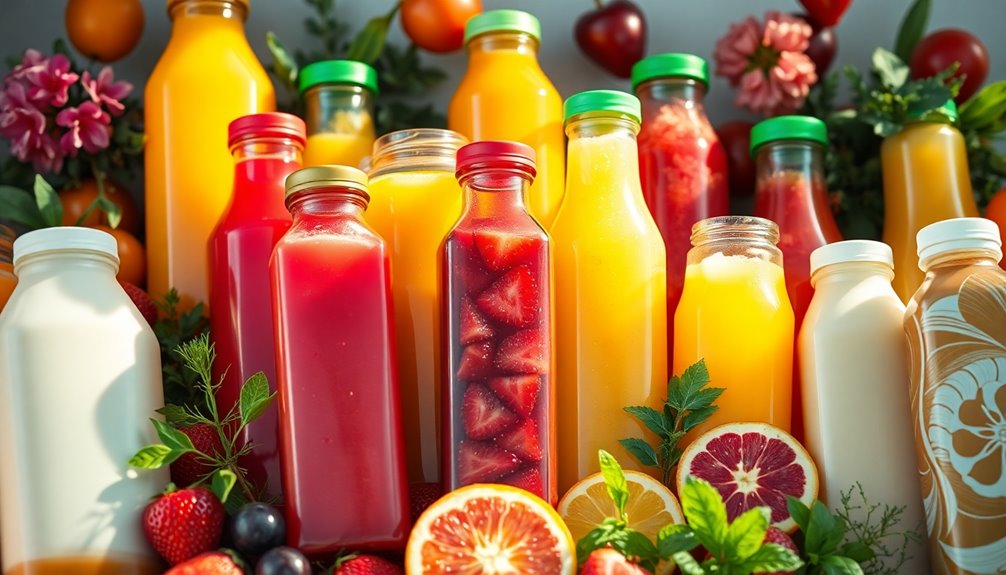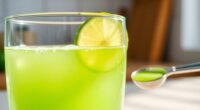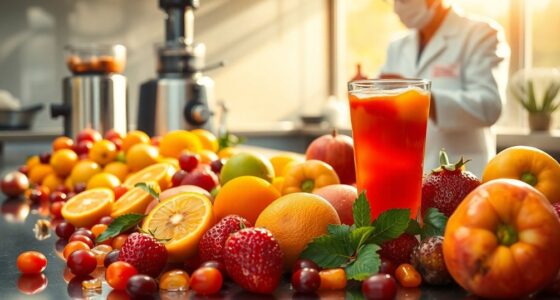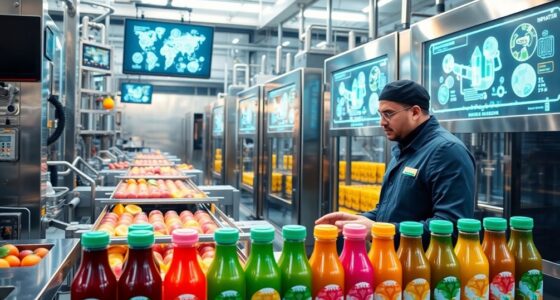To revolutionize your juice storage, embrace trends like eco-friendly packaging and smart solutions that enhance freshness. Single-serving containers and resealable options cater to your on-the-go lifestyle and promote sustainability. Innovations in technology, such as encapsulation techniques and digital printing, keep your juices fresh while providing essential nutrients. Addressing rising transportation costs with lightweight and efficient designs is vital. Discover more about how these advancements can elevate your juice experience and meet your evolving needs.
Key Takeaways
- Eco-friendly packaging, such as compostable materials and reduced plastic content, is increasingly demanded by consumers in the juice industry.
- Active packaging technologies, including oxygen scavengers, significantly enhance juice freshness and shelf life, preventing spoilage.
- Single-serving and resealable packaging options promote convenience, responsible consumption, and waste reduction among consumers.
- Advanced preservation techniques, like encapsulation and freeze-drying, protect nutrients and extend the longevity of juice products.
- Innovative designs, including lightweight materials and digital printing, optimize user experience and reduce transportation costs for juice brands.
The Rise of Eco-Friendly Packaging Materials

As consumers become more aware of environmental issues, the demand for eco-friendly packaging materials in the juice industry is on the rise. A third of US consumers are worried about non-sustainable packaging, pushing brands to innovate.
Solutions like Foopak Bio Natura paperboard coatings, which feature less than 0.75% plastic, meet recycling and compostability standards, enhancing sustainability in juice packaging.
In the UK, 40% of juice drinkers are concerned about food miles, prompting brands to use native ingredients. Additionally, companies like Don Simon are setting triple zero targets to build transparency and trust.
Aseptic cartons from Tetra Pak further revolutionize juice storage, emphasizing multilayer paperboard-based solutions that align with eco-friendly packaging expectations.
The shift is clear: sustainability is becoming the industry standard. Furthermore, the juice industry can benefit from solar energy solutions, which can reduce production costs and enhance sustainability efforts.
Smart Packaging Solutions for Enhanced Freshness
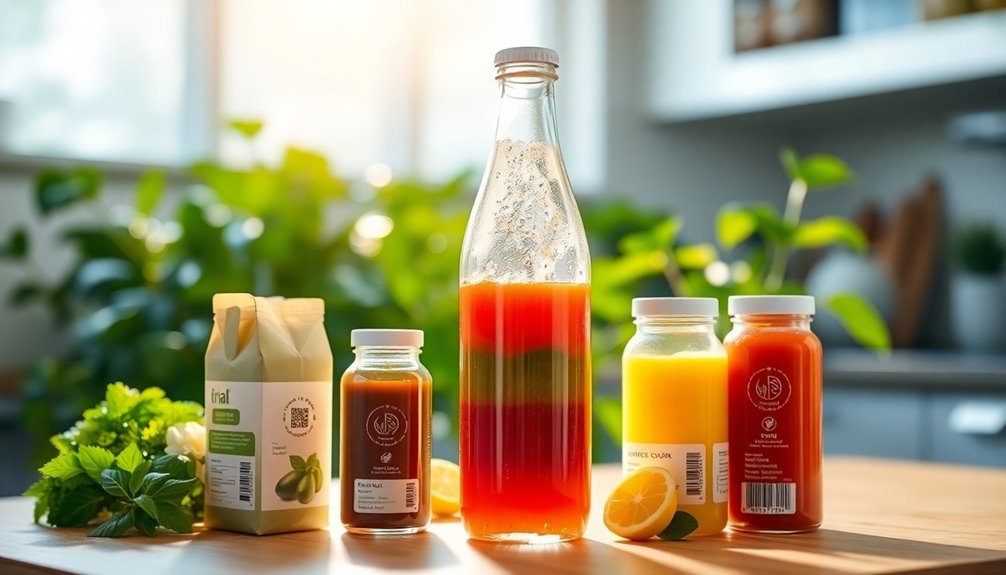
Smart packaging solutions are changing how you think about juice freshness.
With active packaging technologies and intelligent temperature monitoring, you can guarantee your favorite juices stay flavorful and safe to drink.
Plus, using eco-friendly materials means you can enjoy your juice while supporting sustainability efforts. Additionally, incorporating healthiest fruit juice varieties can further enhance the nutritional profile of your stored juices.
Active Packaging Technologies
Active packaging technologies have revolutionized how juice products maintain freshness and extend shelf life. These smart solutions actively manage storage conditions, keeping your juice safe and tasty.
Here are some key benefits of active packaging technologies:
- Oxygen scavengers reduce oxidation, prolonging flavor and color.
- Moisture regulators help prevent spoilage by controlling humidity levels.
- Antimicrobial materials inhibit the growth of spoilage microorganisms, enhancing safety.
- Temperature-sensitive inks signal exposure to damaging conditions for better quality control.
With brands adopting these innovative technologies, you can expect your juice to not only taste fresher but also meet rising consumer demands for sustainability and quality. Additionally, using energy-efficient systems can further reduce operational costs associated with juice storage.
Embracing active packaging technologies is a smart move for both producers and consumers alike!
Intelligent Temperature Monitoring
Maintaining juice freshness goes beyond innovative packaging; intelligent temperature monitoring plays an essential role.
These systems automatically track and adjust storage conditions throughout the supply chain, which can reduce spoilage rates by up to 30%. With advanced sensors integrated into juice containers, you'll receive real-time alerts about any temperature deviations, allowing for timely corrective actions to preserve freshness.
This not only enhances product safety but also builds consumer trust—72% of customers prefer brands using smart technology for freshness.
As the global smart packaging market is projected to reach $49 billion by 2028, it's clear that the demand for intelligent temperature monitoring is rising, ensuring your juice products maintain their quality and appeal.
Eco-Friendly Materials Usage
As the demand for sustainable practices grows, the juice industry is turning to eco-friendly materials that not only enhance freshness but also align with consumer values.
By adopting these innovative solutions, brands can notably reduce their environmental impact while ensuring quality.
Here are some key trends in eco-friendly materials usage:
- Paperboard coated with bio-based emulsions: Prevents grease absorption and is plastic-free.
- Tetra Pak's multilayer cartons: Combine aluminum and paperboard for extended shelf life.
- Metallized films: Reduce oxygen permeability, improving juice freshness.
- Digital printing on packaging: Allows rapid updates to ingredient listings, enhancing consumer transparency.
These smart packaging solutions not only meet sustainability standards but also keep your juice tasting fresh longer. Additionally, the incorporation of eco-friendly materials can further support the health benefits of juices, such as promoting skin health and enhancing detoxification.
Portion Control: Catering to On-the-Go Lifestyles
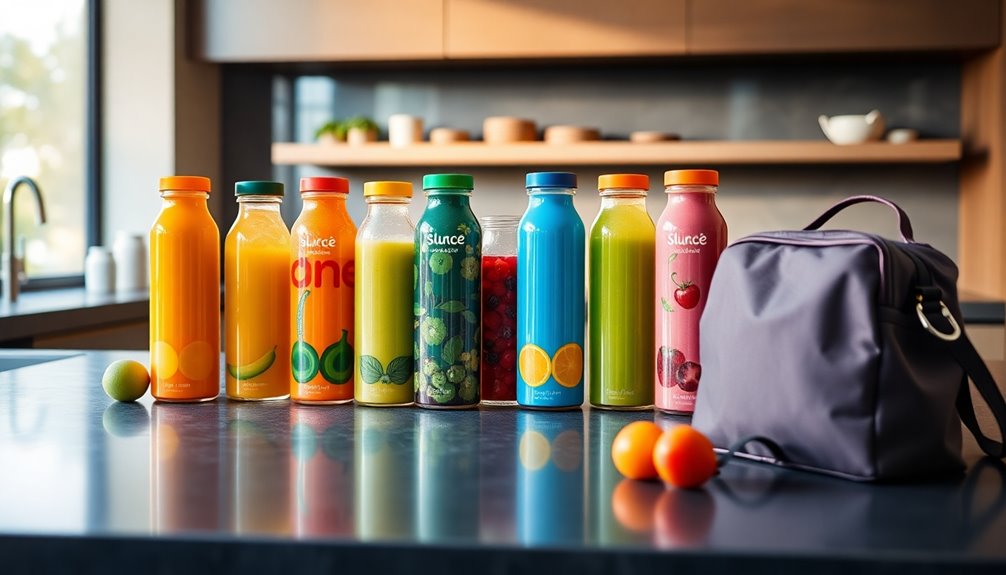
With the hustle and bustle of modern life, portion control in juice packaging has become essential for those seeking convenience without compromising health.
You'll find that single-serving containers are growing in popularity, perfect for fitting healthy juice choices into your busy schedule. As 72% of UK consumers look to save money, brands are responding by offering smaller, affordable packaging options.
These portion-controlled choices not only help you manage your budget but also limit sugar intake, with many health-conscious drinkers opting for one small glass a day. Additionally, incorporating fresh herbs into these portioned juices can enhance flavor and nutritional value, making them a more appealing choice.
The demand for portable products, like squeeze bottles and pouches, reflects your need for easy consumption while maintaining freshness.
Portion control truly caters to your on-the-go lifestyle.
Resealable Options: Convenience Meets Sustainability
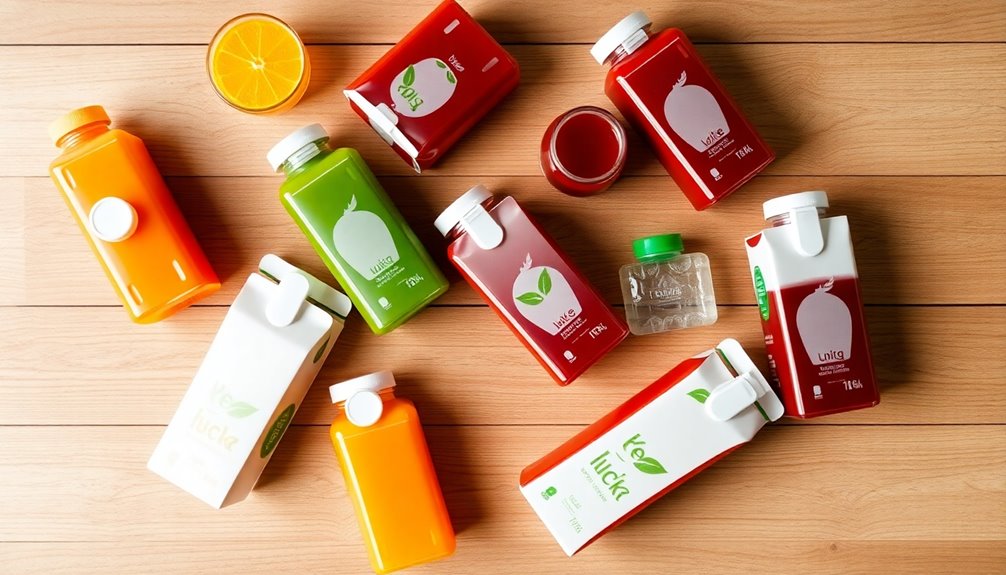
While you enjoy your favorite juice, resealable packaging options make it easy to indulge in smaller portions without sacrificing freshness.
These convenient designs not only cater to your lifestyle but also align with a growing focus on sustainability. With 40% of UK consumers concerned about non-sustainable packaging, brands are responding by introducing eco-friendly materials that decrease waste.
Consider the benefits of resealable packaging:
- Keeps juice fresh for longer
- Reduces waste through responsible consumption
- Offers user-friendly features for easy pouring
- Enhances portability for on-the-go enjoyment
As you sip, you can feel good knowing you're choosing products that support both convenience and the environment, driving the trend towards sustainability in juice storage. Additionally, this trend reflects a broader movement towards personal development and mindful consumption as consumers become more aware of their choices.
Innovative Designs That Improve User Experience
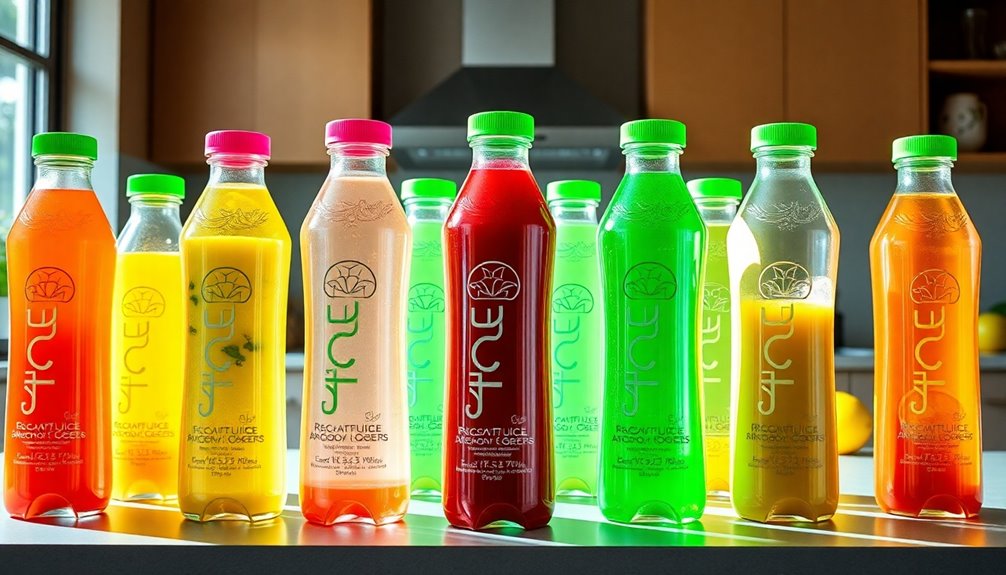
Innovative designs in juice packaging not only enhance user experience but also cater to modern consumer needs. From aseptic cartons to lightweight PET bottles, these advancements improve convenience and safety. For instance, digital printing technology allows brands to update packaging quickly, ensuring you have the latest nutritional info at your fingertips. Additionally, incorporating nutritional advantages of green juice can further attract health-conscious consumers who prioritize functional benefits.
| Design Feature | Benefits |
|---|---|
| Aseptic Cartons | Longer shelf life |
| Lightweight PET Bottles | Easier handling |
| Innovative Paperboard Coatings | Grease and oil resistance |
The Impact of Sustainability on Juice Packaging
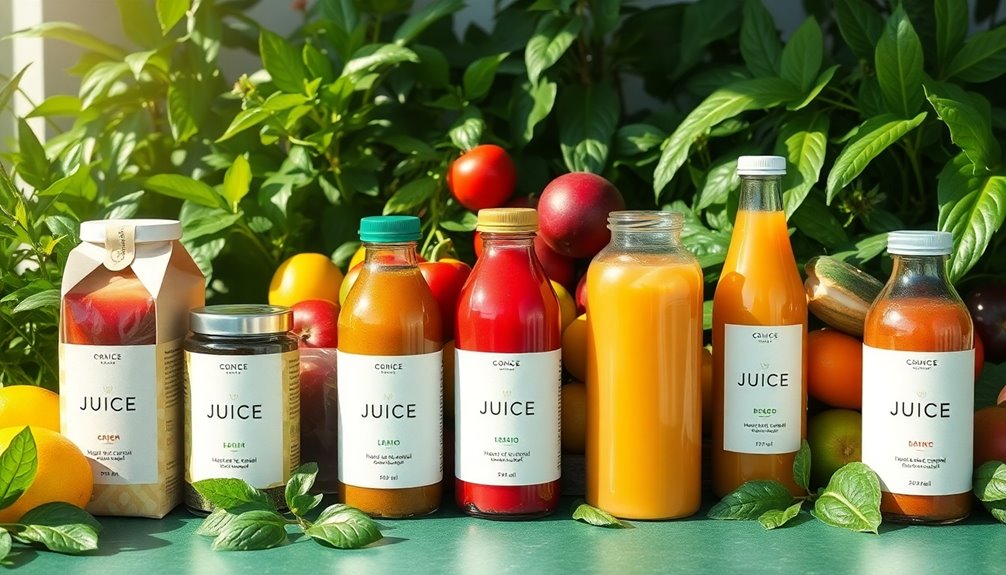
As consumers become more environmentally conscious, the impact of sustainability on juice packaging has never been more pronounced.
You might notice that brands are stepping up their game to meet your expectations. Here are some key trends:
- Focus on local ingredients to reduce food miles and environmental impact.
- Eco-friendly packaging options, like plastic-free and compostable materials, are becoming the norm.
- Transparency measures, such as Don Simon's triple zero target, help build trust in sustainability efforts.
- Increased demand for innovation, driven by consumer awareness during the cost of living crisis.
- The use of HEPA filtration technology in juice packaging facilities ensures a cleaner environment for processing, enhancing product safety.
These trends reflect a significant shift towards sustainability in juice packaging, ensuring that your choices align with a greener future.
Consumer Preferences: Health-Conscious Packaging Choices
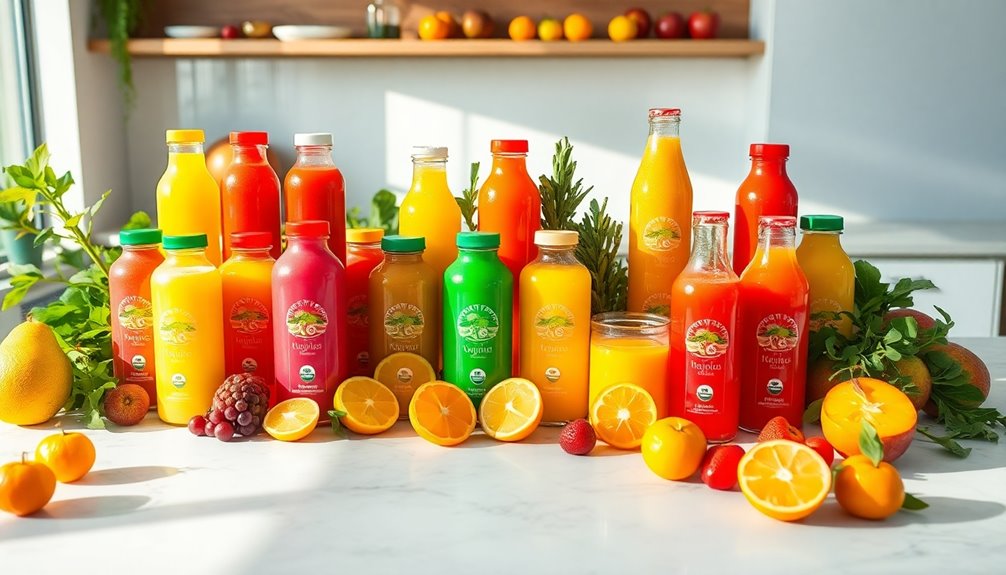
With growing awareness of health and wellness, many consumers are now prioritizing packaging that reflects their lifestyle choices. You want to support brands that embrace sustainable packaging, and you're not alone—40% of UK consumers share your concerns. In the U.S., a third of consumers also prioritize eco-friendly options.
| Consumer Concern | Preference |
|---|---|
| Non-sustainable packaging | 40% UK consumers |
| Locally sourced materials | 40% UK juice drinkers |
| Transparent strategies | Builds consumer trust |
The anticipated post-cost of living crisis could further amplify these preferences, making it essential for juice brands to adopt innovative, sustainable packaging solutions. When you choose wisely, you're supporting a healthier planet! Additionally, understanding consumer preferences can help brands tailor their products to meet the evolving demands of their audience.
The Role of Technology in Juice Storage Solutions
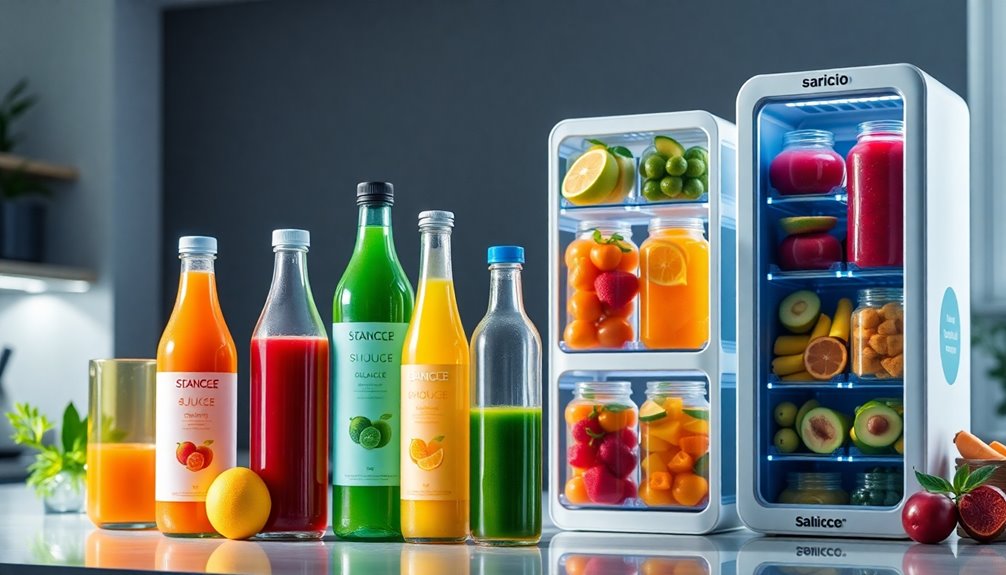
Technology plays an essential role in enhancing juice storage solutions, ensuring that the nutritional benefits remain intact during distribution. By leveraging innovative techniques in food packaging, you can markedly improve the quality and longevity of juice products.
Here are some key advancements:
- Advanced encapsulation techniques enhance stability and shelf life of bioactive compounds.
- Spray-drying and freeze-drying protect sensitive ingredients from environmental degradation.
- Emulsion-based systems boost nutrient delivery and bioavailability.
- Eco-friendly packaging materials, like biodegradable coatings, address consumer sustainability concerns.
These technologies not only preserve the integrity of juices but also cater to health-conscious consumers. Additionally, incorporating essential oils for health conditions can further enhance the flavor and therapeutic benefits of juice products.
With rapid updates enabled by digital printing, you can keep your packaging relevant and compliant with changing regulations.
Embrace these innovations to stay ahead in the juice market!
Reducing Food Waste Through Better Packaging
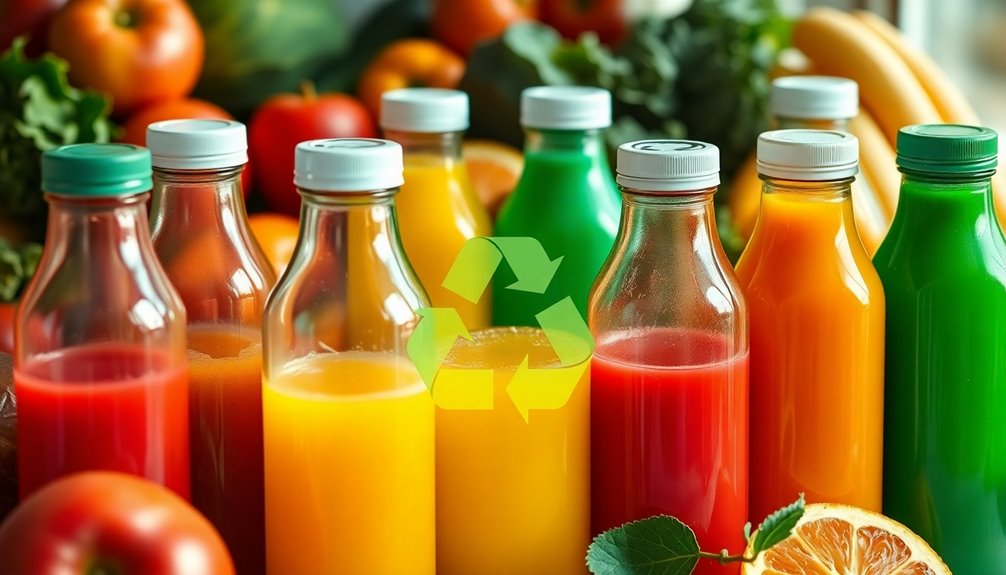
You'll find that sustainable packaging solutions are key in cutting down food waste while enhancing the shelf life of juices.
By using materials that are biodegradable and advanced packaging technologies, you can help keep your juice fresh longer.
This not only benefits your health but also reduces your environmental impact.
Sustainable Packaging Solutions
As consumers increasingly seek environmentally friendly options, sustainable packaging solutions play an essential role in reducing food waste in the juice industry.
By using innovative materials and technologies, producers can minimize waste while ensuring product safety and quality.
Consider these sustainable packaging solutions:
- Tetra Pak's multilayer paperboard-based cartons, which have produced over 179 billion packages in 2023.
- Eco-friendly materials, like paperboard with less than 0.75% plastic, addressing consumer concerns.
- Aseptic cartons that prevent spoilage and extend product life.
- Encapsulation techniques that enhance nutrient stability, reducing waste.
Enhanced Shelf Life
While many consumers appreciate the convenience of ready-to-drink juices, the challenge of food waste remains a significant concern.
Fortunately, advancements in packaging technology are paving the way for enhanced shelf life. Aseptic cartons and metallized films prevent oxygen exposure and contamination, critical factors in reducing spoilage.
Meanwhile, encapsulation techniques help maintain the nutritional value of juices over extended periods. Eco-friendly materials not only align with sustainability goals but also protect products from environmental factors, further extending their longevity.
Innovations like water-based dispersion coatings create moisture barriers, enhancing food safety.
Finally, rigorous migration testing guarantees harmful substances don't leach into your juice, giving you peace of mind and a fresher product for longer.
Embracing these trends means less waste and more enjoyment.
Addressing Transportation Costs With Efficient Packaging
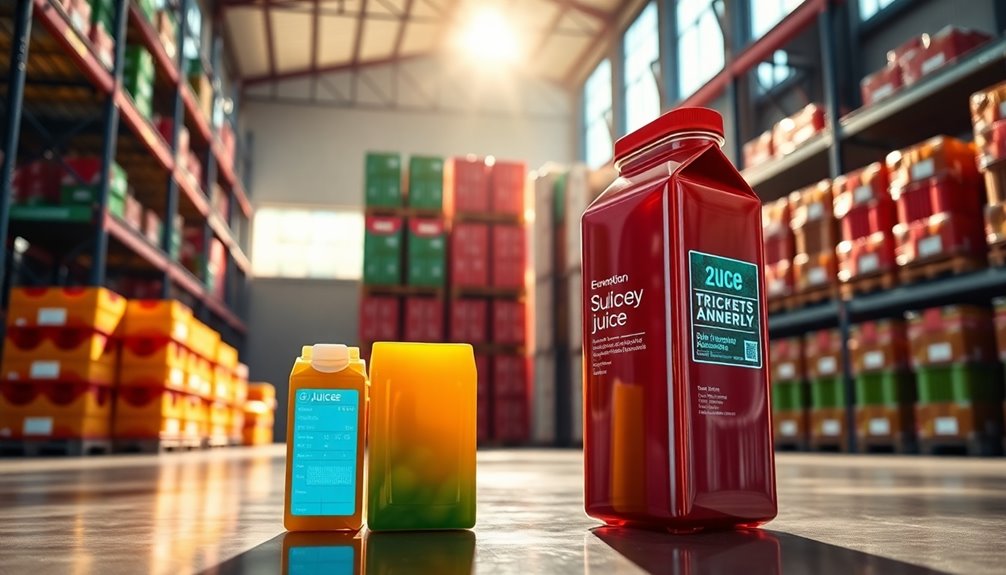
Given the rising transportation costs in the juice industry, brands are prioritizing efficient packaging solutions to stay competitive.
By adopting innovative packaging strategies, you can greatly reduce shipping expenses while ensuring product quality. Here are key solutions to evaluate:
- Lightweight materials like PET bottles cut down shipping weight.
- Aseptic cartons enhance shelf life and decrease transport frequency.
- Metallized films and paperboard laminates minimize oxygen permeability for better quality during transit.
- Digital printing technology allows for quick label updates, reducing waste and lead times.
Future Trends in Juice Packaging: What to Expect
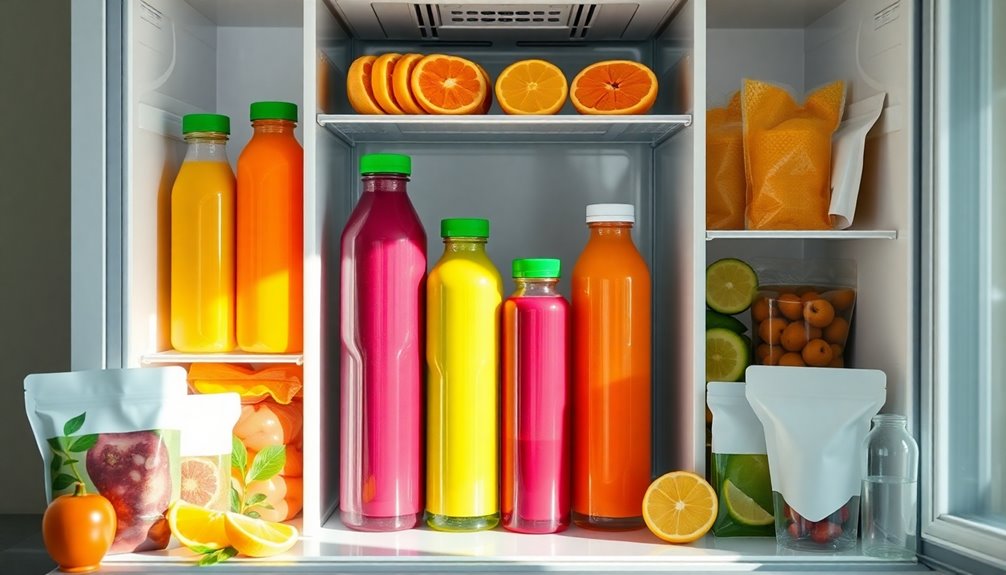
As you look ahead in the juice packaging industry, expect a significant shift toward eco-friendly materials that resonate with consumer values.
You'll also see advancements in enhanced shelf-life solutions and innovative designs that not only protect the product but also promote transparency and sustainability.
These trends are shaping a future where packaging aligns with the growing demand for healthier, natural options.
Eco-Friendly Materials Adoption
With consumers increasingly prioritizing sustainability, juice brands are rapidly adopting eco-friendly packaging materials to stay competitive. A significant number of US consumers express concern over non-sustainable packaging, driving brands to rethink their strategies.
Here are some key trends to watch:
- Adoption of biodegradable options, like Foopak Bio Natura paperboard, which meet compostability standards.
- Utilization of aseptic cartons, such as Tetra Pak, for high-barrier solutions that minimize environmental impact.
- Implementation of digital print technologies for rapid updates and waste reduction.
- Focus on sustainable packaging to lower food waste while maintaining product quality.
These innovations underscore the food industry's shift towards eco-friendly materials, ensuring juice packaging aligns with consumer values and enhances long-term sustainability.
Enhanced Shelf-Life Solutions
Consumers' growing concern for sustainability is influencing not just packaging materials but also how juice brands approach shelf life. Enhanced shelf-life solutions are now at the forefront, utilizing advanced materials like metallized films and multilayer aseptic cartons. These options considerably reduce oxygen permeability, keeping your juice fresher for longer.
Additionally, eco-friendly packaging, such as paperboard with low plastic content, meets sustainability expectations while shielding juices from environmental factors that can affect their quality. Innovations in encapsulation techniques help preserve bioactive compounds, enhancing stability and nutritional value.
Plus, digital printing technology allows for quick labeling updates, ensuring compliance with health standards and boosting your confidence in product freshness. Embrace these trends for a better juice experience!
Innovative Packaging Designs
Innovative packaging designs are set to transform the juice industry, emphasizing both functionality and sustainability. These advancements focus on creating containers that not only keep the product fresh but also minimize environmental impact. The latest breakthroughs in juice packaging include the use of biodegradable materials and advanced sealing techniques that extend shelf life without compromising quality. By prioritizing eco-friendly solutions, manufacturers are appealing to a more conscious consumer base while also setting new industry standards.
As you explore the future of fruit juices, you'll notice several trends that enhance convenience and environmental responsibility:
- Aseptic cartons by Tetra Pak guarantee ideal shelf life while preserving juice integrity.
- Lightweight PET bottles offer a non-breakable option, making them easy to carry.
- Digital printing technology speeds up label updates by 30%, adapting to consumer preferences quickly.
- Eco-friendly solutions like paperboard with plastic-free coatings cater to the rising demand for sustainable packaging.
These innovative packaging designs not only enhance user experience but also align with the growing focus on sustainability, making your juice choices more conscious and enjoyable.
Frequently Asked Questions
What Is the Future of the Juice Industry?
The future of the juice industry looks promising if you adapt to changing consumer preferences.
You'll need to focus on offering healthier, less sweet options and innovative, functional products. Emphasizing sustainability will be essential, as consumers increasingly prioritize eco-friendly practices.
With price sensitivity on the rise, exploring cost-effective solutions can help you capture budget-conscious shoppers.
What Is the Best Packaging for Fruit Juice?
Choosing the best packaging for fruit juice is like picking the right armor for a knight; it protects and preserves the treasure inside.
Aseptic cartons are excellent for extending shelf life, while PET bottles offer convenience and safety.
You'll love how metallized films keep flavors fresh and digital printing allows quick updates.
Plus, encapsulation techniques help maintain the nutritional quality, ensuring you get the best juice experience in every sip.
What Is the Best Way to Store Juice?
To store juice effectively, use airtight containers like PET bottles to prevent oxidation.
Keep your juice in a cool, dark place to maintain freshness and nutrient quality.
Aseptic cartons can also extend shelf life by protecting against spoilage.
If possible, opt for eco-friendly packaging to align with sustainability goals.
How to Increase Juice Shelf Life?
When it comes to juice shelf life, you'll want to keep your ducks in a row.
Start by using high-barrier packaging to shield your juice from light and moisture. Aseptic packaging allows for room temperature storage, minimizing spoilage.
Consider adding enzymes for better clarity and flavor.
Remember, proper storage conditions with controlled temperatures and humidity levels are essential.
Conclusion
Just like a well-tended garden, the evolution of juice storage and packaging nurtures a thriving ecosystem of convenience and sustainability. As you embrace these trends, you're planting seeds for a fresher future, where eco-friendly materials and smart designs flourish. By choosing innovative solutions, you're not just quenching your thirst; you're cultivating a healthier planet. So, let your choices ripple through the industry, transforming how we enjoy juice and protecting our resources for generations to come.
Cindy thoroughly researches juicing trends, techniques, and recipes to provide readers with practical advice and inspiration. Her writing style is accessible, engaging, and designed to make complex concepts easy to understand. Cindy’s dedication to promoting the advantages of juicing shines through her work, empowering readers to make positive changes in their lives through the simple act of juicing.

